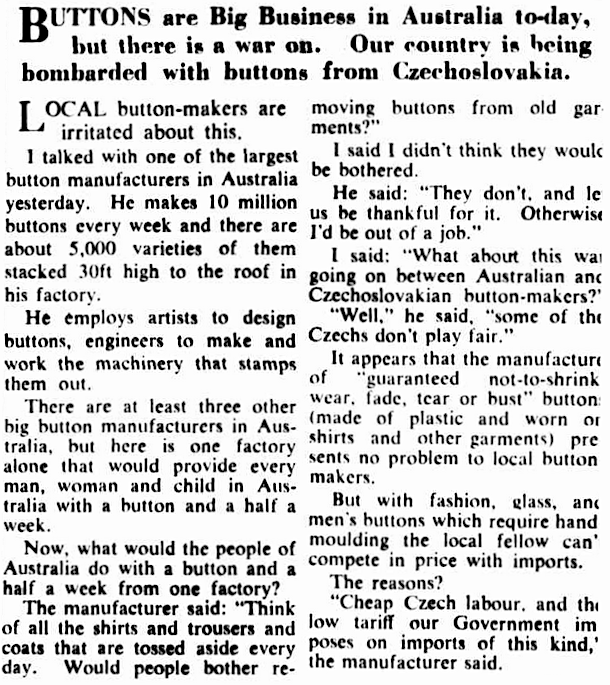A Button Identity Corrected
Victorian Corps of Commisssionaires

Backmark: Stokes
Previously I had identified this button as belonging to the Campaigners for Christ Volunteers. An alternate identity has been proved to be true: the Victorian Corps of Commisssionaires. Along the way of investigating this, representatives of both organisations claimed the button as their own!
Campaigners for Christ
In 1936 a group of businessmen and Christian laymen in Melbourne and Sydney formed the Campaigners for Christ. During WW2 they were given permission to serve the forces by setting up “Everyman’s Huts” (and later Everywoman’s) for refreshment and entertainment. The staff wore military style uniforms and held honorary Officer status. These services were funded by donations. They still support the military today. Their logo shows an overlapping double C, very similar to that on the button.

Kenneth Matthews, Everyman’s Chief Commissioner, replied to me.
“Just getting back to you over the button. The best evidence we can get from our surviving members from that time is that it was from us. But that was an un-authorised production button most probably produced by one of our individuals without Board approval. For that reason it was either never worn or at least never worn extensively. It looks like a Victorian “V” Campaigners for Christ button but anyone who was around at that time from that branch is now no longer with us.
So you could say that it is an unofficial Victorian Campaigners for Christ button. Much like some old military insignia that is around, that was certainly worn even in conflict, but never was officially recognised by the army it was intended to represent.”
However, as George Zagon of The Corps pointed out “If one looks very closely the vertical C goes UNDER the horizontal C at the top of the crest and the horizontal C goes UNDER the vertical C at the bottom of the crest. The Corps’ C C on the button is the opposite. A subtle difference, but different.” A good point, although errors have been known on button designs in the past!
Corps of Commissionaires
http://www.thecorps.com.au/
In the collection of Melbourne Legacy is a photo of Jim Tierney wearing his Corps uniform.

I received this information from George Zagon:
In reference to the picture of the button you sent me, I can assure you that it is the only button that The Corps of Commissionaires have used on our uniforms since moving operations to Victoria from NSW after WW2.
The Corps Australia was formed in Australia in 1939 with the head quarters in Sydney. The uniform button then would have been just C and C , as seen in the Campaigners for Christ badge/crest, also established in the early 1930s I believe, but in Victoria.
However, when the heads quarters were moved to Victoria, the “V” was included in the button, and was the approved uniform button ( by our founding Corps in the UK and an organisation I can’t remember the name off, here in Australia, that dealt with military uniforms).
I have asked a number of our older members if there has been any changes to the button design over their time with The Corps, and no one can remember any changes.
My only query regarding the Campaigners for Christ button would be : ” why does the V not appear on their badge as it was founded in Victoria?”.
I hope this clarifies the situation from The Corps perspective. Either way, there is no problem on The Corps’ part in sharing the button.
Again, thank you for your email, and look forward to any further queries you may have.
Yours Sincerely,
George ZAGON
President
The Corps of Commissionaires Association
AUSTRALIA
He also sent me images of a button and the front of his jacket:

Confusingly, the hat badge for the Commissionaire has a very different design, which originally made me doubt the buttons identity. See the badge with these links:
https://victoriancollections.net.au/items/626dc16a7d0d794d4b7f5cc8
https://victoriancollections.net.au/items/54a8c2bf2162f10f003111bd
See also
http://www.austbuttonhistory.com/defence-forces-uniform-buttons/veteran-organisations/
The button was shown in the book:
Stokes by Leigh Blackburn and Gregory C. Eccleston
Stokes: A proud heritage, 140 years in Australian manufacturing Industry.
Greg passed this message on: “I shall be happy if you can circulate amongst your members the correct identification of the button. The button is mentioned on page 68 (where its identity is described as unconfirmed); shown on page 69 in rows C and D item (3); and identified incorrectly and illustrated as C 062 on page 121.”
For any comment or questions, please use the Contact page.








































